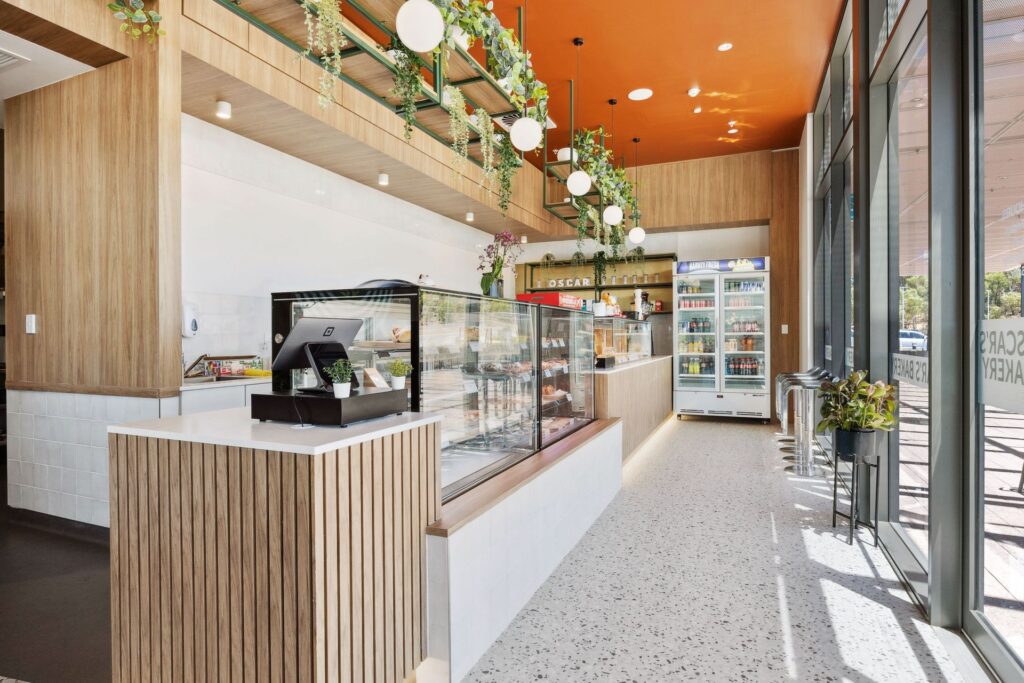As sustainability becomes a driving force in construction and design, more businesses are looking to reduce their environmental impact while creating modern, functional workspaces.
Sustainable commercial fitouts combine aesthetic appeal, long-term cost savings, and environmental responsibility.
We’ll explore the most important aspects of incorporating eco-friendly building materials into your next fitout – and how partnering with the right commercial fitout company can make all the difference.

Why Choose a Sustainable Fitout?
Choosing sustainable interior design isn’t just about environmental ethics; it’s also about creating healthier, more productive spaces for both employees and customers to enjoy.
Here are some compelling reasons to go green in your next fitout project:
Energy efficiency: Many sustainable materials are designed to improve insulation, regulate temperatures, and reduce the need for artificial heating and cooling.
Health benefits: Non-toxic materials improve indoor air quality by reducing the presence of harmful chemicals, such as VOCs (volatile organic compounds).
Corporate responsibility: A commitment to sustainability can boost your brand reputation and resonate with environmentally conscious clients and communities. It also demonstrates long-term responsibility, setting your business apart in an increasingly values-driven market.
Cost savings: While sustainable materials may have a higher upfront cost, they often prove more-cost effective than conventional alternatives in the long-run, due to their durability and energy efficiency.
Top Sustainable Materials for Commercial Fitouts
Whether you’re looking for a green office design, a shop renovation, or a new restaurant fitout, here is a breakdown of some of the most popular and effective materials used in fitout projects:
Reclaimed Wood
One of the most popular eco-friendly building materials, reclaimed wood is salvaged from old buildings, barns, and furniture. It offers a warm, natural aesthetic while reducing demand for freshly harvested timber.
Uses: flooring, feature walls, furniture.
Sustainability factor: reuses existing resources and reduces landfill waste.
Recycled Metal
Recycled aluminium and steel are strong, versatile, and 100% recyclable. These materials are often used in structural framing, partitions, and ceiling systems.
Uses: wall framing, light fixtures, support structures.
Sustainability factor: requires less energy to produce than new metal and is extremely durable.
Low-VOC Paints and Finishes
Traditional paints and adhesives often emit toxic chemicals that can linger in the air for months. Low-VOC (volatile organic compounds) alternatives are healthier for occupants and better for the environment.
Uses: walls, ceilings, furniture finishes.
Sustainability factor: improves indoor air quality and reduces health risks.
Bamboo
As a rapidly renewable resource, bamboo grows far faster than hardwood trees. It’s durable, flexible, and has a clean, modern look that suits a range of interior styles.
Uses: flooring, panelling, furniture.
Sustainability factor: matures in 3–5 years and requires minimal pesticides or irrigation.
Recycled Glass
Crushed and repurposed glass can be transformed into stylish countertops, tiles, and decorative features.
Uses: benchtops, partitions, decorative panels.
Sustainability factor: diverts waste from landfills and reduces demand for new glass.

Top Tips for a Sustainable Commercial Fitout
Using sustainable materials is only part of the equation; efficiency and long-term sustainability should also be prioritised.
Here are some design elements that align with green office design principles:
Natural lighting: Consider the placement and size of windows to maximise natural light throughout the space. Also, avoid obstructing natural light where possible (i.e. with heavy window curtains, bulky furniture, or solid room dividers) and use glass partitions to reduce reliance on artificial lighting.
Energy-efficient systems: Upgrade to LED lighting, smart HVAC systems, and motion-sensor controls, to reduce energy consumption and lower utility costs.
Biophilic design: Incorporate plants and natural elements to improve indoor air quality and improve staff general wellbeing and productivity.
Modular furniture: Where possible, use modular systems that can be reconfigured as your business evolves, helping to minimise waste over time.
How a Commercial Fitout Company Can Help
Partnering with an experienced commercial fitout company is essential when planning a sustainable project. Look for a team that has experience in sourcing sustainable materials and understands local green building standards.
A knowledgeable fitout partner can:
• Recommend the best eco-friendly building materials for your budget and goals.
• Ensure compliance with sustainability certifications, such as Green Star.
• Coordinate with suppliers who prioritise ethical sourcing and reduced carbon footprints.
• Offer design solutions that minimise construction waste and energy consumption.
Sustainable commercial fitouts are quickly becoming the new standard for companies that value social responsibility, long-term savings, and a healthier work environment.
By improving your energy efficiency, using eco-friendly materials, and working with a forward-thinking commercial fitout specialist, you can create a space that is not only beautiful, but supports the planet and may save you money over time.
If you’re looking for a commercial fitout in Perth, please contact the team at LKD Fitouts to discuss your requirements.






